The Chili Rasbora, a nano schooling fish, is a cherished addition to planted tanks due to its small adult size and vibrant red color. While caring for these stunning nano fish isn’t difficult, achieving their breeding conditions may require some experience. Nevertheless, nurturing a school of Chili Rasboras in a tank can be incredibly rewarding, , I’ll guide you on how to properly care for these exceptional fish.
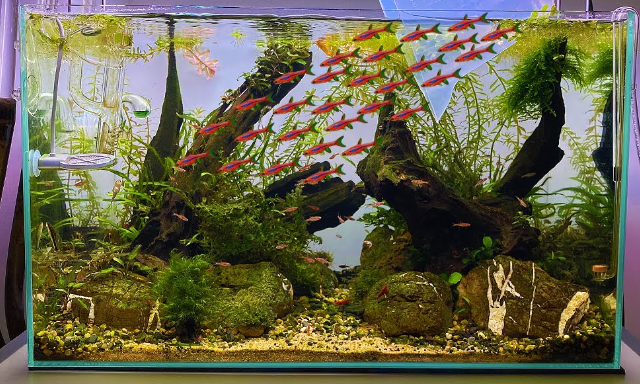
The Chili Rasbora is a nano schooling fish that is a cherished addition to a planted tank due to its small adult size.
Taking care of these stunning nano fish is not difficult, but a beginner may not be able to achieve their breeding conditions.
Nevertheless, looking after a school of Chili Rasboras in a small tank can be very rewarding and their lifespan justifies the effort.
In this article, I’ll teach you how to take proper care of the exceptional Chili Rasbora fish.
Introduction to the Chili Rasbora
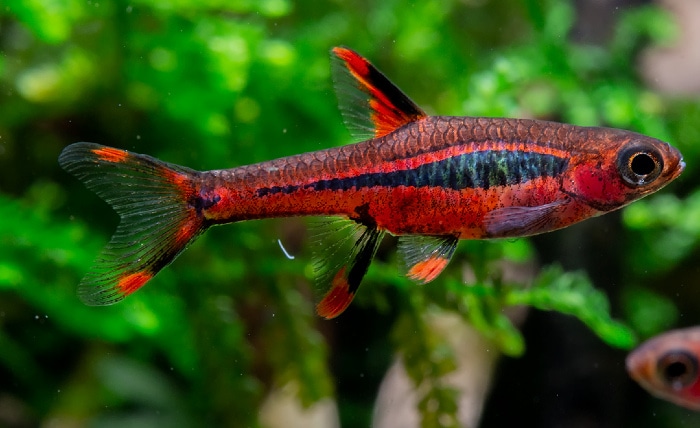
by Nigel Aquascaping
| Care Level: | Medium |
| Temperament: | Peaceful and timid |
| Social Behavior: | Prefers large schools |
| Maximum Adult Size: | 0.78 inches or 2 cm |
| Minimum Tank Size: | 5 gallons |
| Diet: | Omnivore with a preference for meat |
| Lifespan: | 4 to 8 years with good care |
| Compatibility: | Other peaceful nano fish that like tropical temperatures |
| Suggested Setup: | Heavily planted aquarium |
The Chili Rasbora comes from the Boraras genus of cyprinid micro fish.
This freshwater fish species is known as Boraras brigittae, but you can also see it labeled as a Mosquito Rasbora in the commercial aquarium trade.
Despite its more popular names, the Chili Rasbora is not a true Rasbora.
The Chili Rasbora fish is native to jungles in the Southern parts of Borneo, an island in Southeast Asia, Indonesia.
There, the fish naturally inhabits the acidic, soft blackwater of peat swamp forests. The water of these swamps is low on minerals and is stained dark brown by the high levels of acidic tannins it contains.
Anyhow, aquarists generally prefer to keep Chili Rasbora fish in sophisticated planted aquariums. It is somewhat rare to see a varied fish community in an aquarium with this micro fish because the Chili Rasbora is timid and prefers single-species communities.
Expert aquarists agree that at least some experience in the aquarium hobby is needed to be able to take proper care of a Chili Rasbora school from the first try.
Maximum body size of an adult specimen

by User2716057
The Chili Rasbora fish grow up to 0.78 inches (2 cm) in their adulthood.
Rarely a specimen would reach 1 inch or 2.54 cm in full body length.
The size of a newly hatched Chili Rasbora fry is around one-fourth that of an adult.
Author’s note: Chili Rasboras are deceptively small. If you’ve never seen them in person you would likely imagine them larger than their actual size. Keep this in mind when you’re starting your new Chili Rasbora aquarium.
Anyway, the maximum body size of the Chili Rasbora makes it one of the smallest schooling fish kept in freshwater aquariums. In terms of sexual differences, the two sexes are almost indistinguishable at first glance.
The most notable difference between them is the bright red stripes that adorn the anal and dorsal fins of males.
Apart from this, female chilis tend to have rounder bellies and are usually larger.
Schooling behavior and recommended size of the school

by UneekSole
The Chili Rasboras are a schooling species of fish and need to remain in groups to establish their own social hierarchy. In the aquarium, they won’t just stay together – they will synchronously swim next to each other.
To prevent your Chili Rasbora fish from leading an unfulfilling social life, you need to keep them in schools of at least 6 members.
Keeping a school of less than 6 Chili Rasboras in a tank would ultimately lead to stress and a reduced lifespan for the fish. From my experience, a healthy school of Boraras brigittae should have at least 12 specimens.
Author’s note: On top of being really small, Chili Rasboras do not like continuously swimming over long distances. The school would swim in intervals and over very short lengths, unlike other schooling fish species.
This schooling behavior makes it possible to put more Chili Rasbora fish in tanks that do not have long horizontal lengths.
Expected lifespan with proper care
A Chili Rasbora has a life expectancy of 4 to 8 years when kept in pristine water quality.
This is a relatively long lifespan for freshwater micro fish.
However, keep in mind that you should replicate the water conditions in the natural habitat of the Chili Rasbora, for it to live 5 or more years in captivity.
Taking care of aquarium systems with soft water can be challenging if you have no access to a proper water source.
Usually, captive Chili Rasboras, adapted to harder water and lower temperatures would live between 3 and 5 years.
Temperament

by giareads
The Chili Rasbora fish are timid in nature and prefer a calm aquarium environment.
They have a very peaceful and timid personality.
You will not see your Rasboras nip the fins of other fish.
However, this is not to say that these nano fish will hide and be shy.
If you keep them in a species only aquarium they will feel confident enough to explore it constantly.
If the Chili Rasbora fish in your community tank hide often, then some of their tank mates are likely stressing them out.
Anyway, the way Chili Rasboras live is so free of conflict that they are often suggested as tankmates for aquariums that need to maintain a good shrimp population.
Hardiness
Though the Chili Rasbora fish is adaptive, it may take time for it to adjust to environmental changes.
Changes that happen slowly, and over time can be tolerated by these Rasboras, but abrupt swings in the water’s parameters are not taken well. If you fail to maintain the stability in the aquarium, your Chili Rasboras will become prone to illnesses such as freshwater Ich (White Spot Disease).
Author’s note: Each time I see Chili Rasbora fish introduced to a new tank, it takes around a month before they settle in.
Don’t be alarmed if your new Chili Rasboras have a pale color for the first couple of weeks after bringing them in.
Also, it’s not uncommon for Chili Rasboras to temporarily lose their color after changing a large portion of the aquarium water. The sudden shift in water parameters that comes with changing aquarium water can put stress on the tiny body of this fish.
This is normal for the Boraras species.
How to Take Care of a Chili Rasbora?
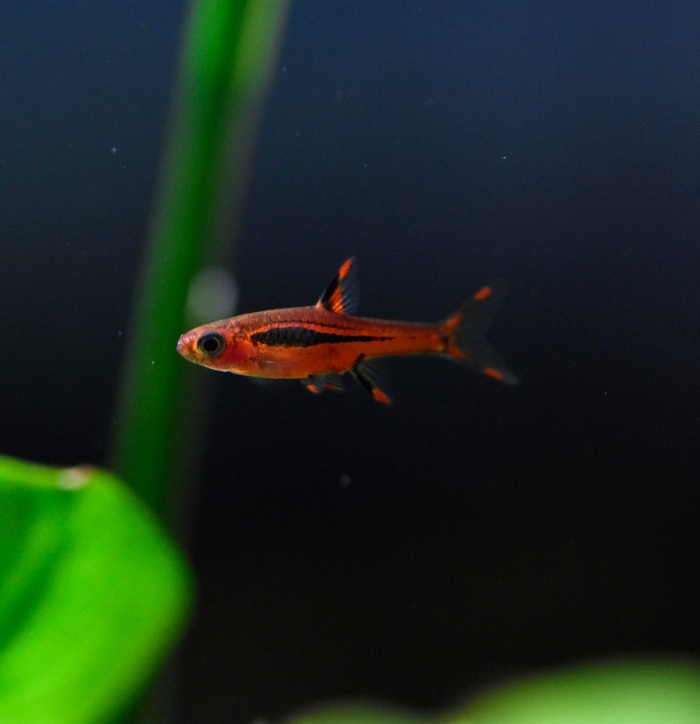
by User2716057
Taking proper care of a Chili Rasbora is not difficult but maintaining stability is key to your success with this species. It can be summarized like this:
A school of Chili Rasbora fish will thrive in clean aquarium water that has stable chemistry and temperature. To avoid stressing these fish you should change their water more frequently and in smaller portions.
The flow from the filter should be minimal because these fish are not used to swimming against a strong current.
Minimum tank size for a school of Chili Rasboras
Because of their small size and the fact that Chili Rasboras don’t do speedy swimming over long distances, these freshwater fish can live in relatively small tanks.
A school of 10 to 12 members could comfortably inhabit a 5-gallon tank as the bare minimum.
The standard dimensions of a 5-gallon aquarium would provide more than enough space for these fish to explore. For larger tanks, you could go by the rule of keeping two Chili Rasbora fish per one US gallon of aquarium water (3.79 liters).
For example, a 10-gallon tank could safely accommodate 20 Chili Rasboras.
Anyhow, the Chili Rasboras are so tiny that their bioload is virtually non-existent.
A small sponge filter would be capable of keeping their aquarium cycled at all times.

by astarbllr
Compatible Tank Mates for Chili Rasboras
Before I start listing tank mates for the Chili Rasbora, I first need to make clear that this fish will feel best in a community tank of its own kind.
However housing it with other companions is possible, but you need to pick carefully:
Ideal tank mates for the Chili Rasbora are fish and invertebrates that are similarly peaceful in nature and also not big enough to prey on it.
This includes small and timid fish like the remaining representatives of the Boraras genus such as the Dwarf Rasbora, the Least Rasbora, and the Phoenix Rasbora.
Other suitable tank companions for a Chili Rasbora would be:
- Honey Gourami
- Dwarf Gourami
- Sparkling Gourami
- Licorice Gourami
- Chocolate gourami (soft aquarium water should be strictly maintained)
- Black Darter Tetra
- Toucan Tetra
- Neon Tetra
- Threadfin Rainbowfish
- Forktail Blue-eyed Rainbowfish
- Red-Neon Blue-eyed Rainbowfish
- Neon Green Rasbora
- Axelrod Rasbora
- Pygmy Corydoras
- Small Betta species that love soft water (not tank-raised Betta splendens)
- Scarlet Badis
- Indonesian Superdwarf fish
- Dwarf Pencilfish
- Freshwater Pom Pom Crabs
- Red Cherry Shrimp
- Crystal Shrimp
Author’s note: I’ve seen some sources listing the Celestial Pearl Danio as suitable tank mates for Chili Rasbora fish, however, that may not turn out as the best setup.
In my experience, Celestial Pearl Danios do better in lower water temperatures whereas the Chili Rasbora needs tropical conditions to thrive.
If you end up putting both species in the same tank you’ll need to adjust the temperature so that it is somewhat cold for the Chili Rasboras and somewhat hot for the Celestial Pearl Danios.
These conditions may lead to a shortened lifespan and an increased chance of catching a disease for both fish species.
Chili Rasboras with Shrimp
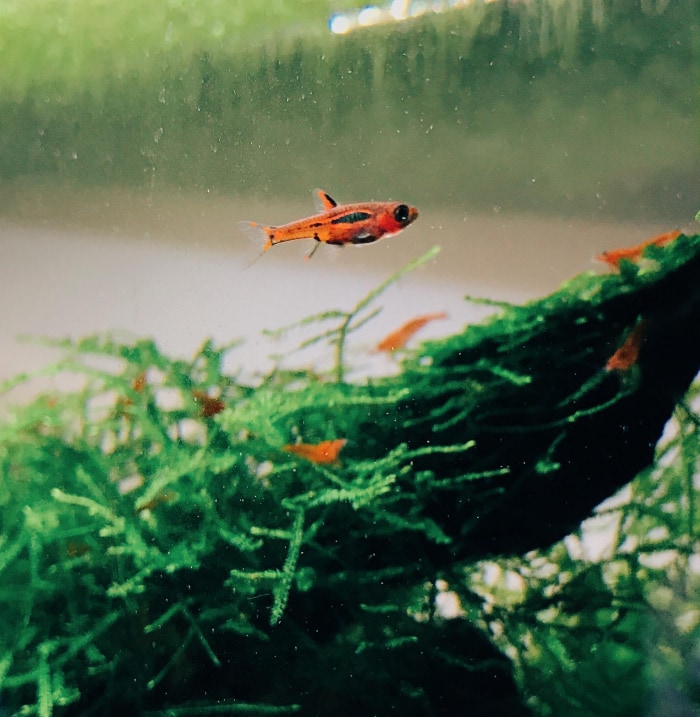
by vamonospestcontrol
If you’re a shrimp keeper then you’re probably excited to have found the Chili Rasbora as a potential addition to your shrimp aquarium.
There are a couple of things I need to clarify before you venture into keeping Chili Rasboras with shrimp.
First, though tiny, the Chili Rasbora will eat shrimp fry, given the opportunity.
These fish are micro predators in their nature and their menu in the wild consists of microcrustaceans.
However, don’t let this discourage you.
The Chili Rasbora fish does not have a strong hunting instinct and will not deliberately chase after shrimplets.
This means that if an unfortunate baby shrimp comes across your Chili Rasbora it will be eaten, but the overall shrimp population in the tank won’t suffer significant losses.
I’ve seen week-old shrimplets getting passed by Chili Rasboras and many shrimp keepers confirm this happening for them too.
In my experience and observations, if a shrimp colony is thriving, even a large school of Chili Rasboras won’t be enough to put the growth of shrimp numbers in the tank at a halt.
Author’s note: I’d recommend establishing a shrimp colony in your aquarium BEFORE adding the Chili Rasboras. This way you’ll be sure that the shrimp will outbreed eventual predation from the fish.
Anyway, the only thing you’d really need to consider when keeping Chili Rasboras and shrimp together would be water parameters.
Red Cherry Shrimp prefer temperature ranges that align with what a Chili Rasbora would like.
However, Cherry Shrimp will not do well in soft, acidic water.
On the other hand, Caridina species such as the Crystal Shrimp will thrive in the soft water that makes a Chili Rasbora happy.
The one thing that keeps Crystal Shrimp from being an ideal tank mate for a Chili Rasbora is that they prefer lower temperatures.
All in all, it’s a matter of compromise and acclimatization for both species.
That being said, I’ve seen functioning aquarium setups where Chili Rasboras were kept with either of the shrimp species mentioned above and everyone seemed well.
Chili Rasboras with Betta fish
Chili Rasboras can and will peacefully live with a Betta, as long as there’s enough room for both species to occupy and the tank is well-planted.
If you don’t have the means to provide your aquarium with plenty of live plants, then I would not recommend trying this setup.
Anyway, your success will also depend on the individual character of your Betta fish.
Some Betta fish species are WAY more aggressive than others.
Your best bet would be to keep your Chili Rasboras with a Betta imbellis instead of the more popular Betta splendens.
Betta imbellis are smaller in size and also peaceful in nature, whereas Betta splendens could be more aggressive and could give your nano fish a hard time.
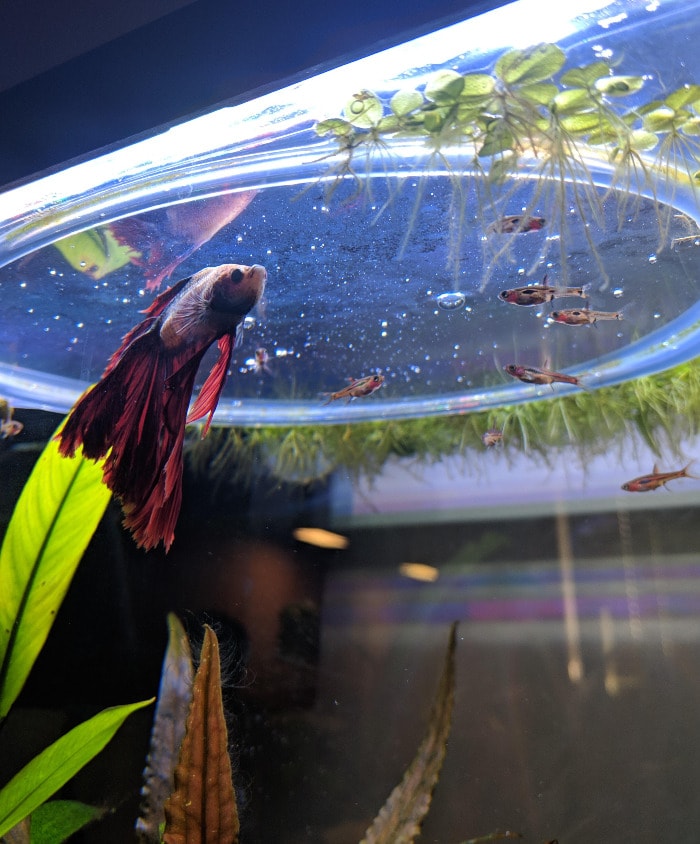
by the_rammer
When it comes to tank size, you could put 6 Chili Rasboras alongside a Betta in a 5-gallon tank. Just make sure your Betta is the calmer type and that the tank has enough live plants to break the line of sight of the fish.
Other peaceful Betta fish that have the same water requirements as a Chili Rasbora and would make a good tank mate for one would be:
- Betta bellica
- Betta coccina
- Betta persephone
- Betta pugnax
Water care and the ideal water parameters for Chili Rasboras
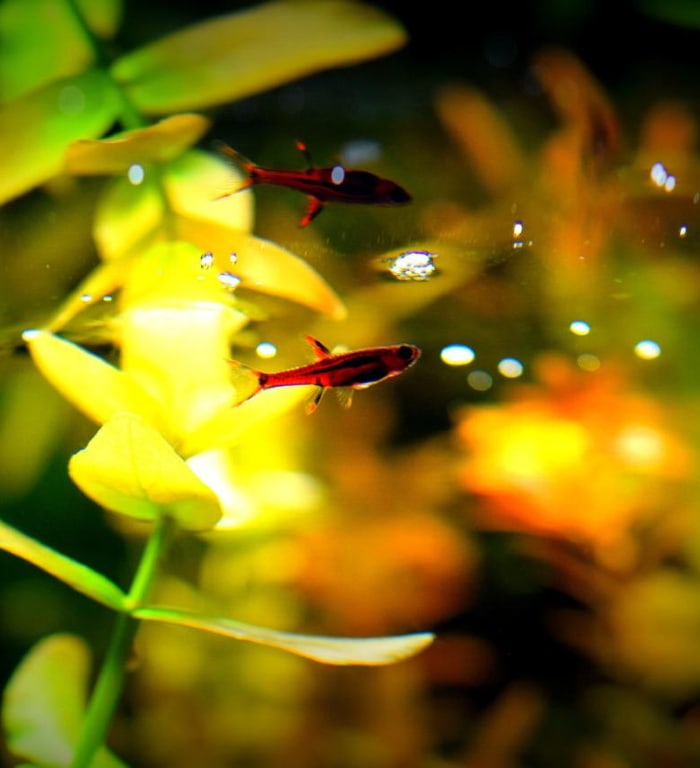
by frozsche
The Chili Rasbora is a freshwater fish that inhabits soft, acidic water with tropical temperatures.
Other characteristics of the ideal tank for these nano fish are dim lighting and slow flow. Chili Rasboras are also extremely intolerant to the presence of Nitrogen in their water. This means it’s essential to keep the Ammonia, Nitrite, and Nitrate at a minimum and, ideally, non-existent.
Here are the optimal water parameters for a Chili Rasbora fish:
- Water temperature: 68 to 82ºF, but ideally between 75 and 80ºF
- pH level: 4.0 to 7.5, where around 5.5 to 6.0 is ideal
- General hardness of water: 1 to 6 dGH, but the fish can be adapted to living in harder water
pH and Water Hardness
The Chili Rasbora fish tolerate pH of between 4.0 and 7.5 but prefer to stay on the more acidic side of that range. Chili Rasboras will do best at between 5.5 and 6.0 pH since this range resembles their natural environment the most.
They also thrive in extremely soft water with a general hardness (GH) of 1 to 6 dGH.
Usually, in the context of fish keeping, soft and acidic water go hand in hand.
If you’re able to keep one the other will come on its own, so to speak.
However, if your tap water is not naturally acidic and soft, then you’d need to get a RO/DI aquarium filtering system of some sort that will neutralize the hardness. Mixing RO/DI water with tap water can give you the wanted acidity and water softness needed to keep your Chili Rasbora fish happy.
Another way to keep the aquarium’s water on the acidic side is by keeping driftwood pieces, Indian almond leaves, or a peat moss extract in it. Each of these will release tannins in the water, staining it dark brown (not making it dirty).
Tannins make the water more acidic in a natural and gradual way and help with boosting the immunity of freshwater fish.
Moreover, this type of brown-stained, tannin-rich water is what closely resembles the natural habitat of the Chili Rasbora.
Anyhow, in theory, all of this can be discouraging for a beginner fish keeper. However, in practice, things are a little bit different.
Nowadays, there are many people that are able to keep their Chili Rasboras in hard water. This is so because fish stores slowly adjust their fish to more achievable water parameters.
The Chili Rasbora fish can adapt to a slow change from soft to hard water.
Author’s note: If you’re keeping Chili Rasbora fish just for fun and do not want to breed them, then a more neutral water hardness would be fine.
This is why I say that beginners who are willing to stay on top of the maintenance can keep this fish, but not breed them.
However, if you’re more experienced in the hobby then I definitely recommend giving the Chili Rasbora tank with soft water a try. The more acidic and soft its water is, the more a Chili Rasbora will truly show its bright, colorful patterns and energetic personality.
Pro tip: Don’t lose hope if the colors of your Chili Rasbora fish seem dull, because you didn’t have the means to keep them soft water. You can use a combination of LED lights with more red diodes and live foods to bring out the color of your fish in a natural way. Luckily, most LED lights designed to grow aquarium plants have strong Red Light channels.
Temperature
The Chili Rasbora could tolerate water temperatures in the range of between 68 and 82ºF or 20 to 28ºC.
However, they feel best and show most of their colors at the upper end of that range.
Keep your Chili Rasboras at between 75 and 82ºF (24 to 28ºC) if you want them to feel at home and thrive. This list of the smallest aquarium heaters may come in handy when starting a tank with tropical nano fish.
Flow rate in the tank
The Chili Rasbora fish is small and not muscular enough to swim against strong currents.
This is because in its natural habitat the water is either still or moving gently.
To not exhaust your Chili Rasboras you should keep the current in their aquarium at a minimum.
Author’s note: A sponge filter is what I would recommend for this type of setup. If you have a larger tank that’s filtered by a strong canister filter, you’d want to secure the intake with a sponge of some sort to prevent it from sucking up the Chili Rasboras.
This is because, at night, these fish gather and leave themselves to flow with the current.
If your filter’s intake is not secured it may end up sucking up the fish.
Ammonia, Nitrite and Nitrate
As with all other freshwater fish, the Ammonia and Nitrite readings in a Chili Rasbora tank should show 0 ppm. However, being freshwater fish that like soft waters, the Chili Rasboras will be a bit more sensitive to higher NitrAte contents in their aquarium.
Ideally, you’d want to keep the Nitrate levels in the tank below 10 ppm. This way you’d avoid the Nitrate’s adverse effects on the fish by not exposing them to it for too long.
Pro tip: Adding some floating aquarium plants to your Chili Rasbora setup is one of the best natural ways to keep Nitrate in check.
Your Chili Rasboras will also love the hideout spots and shades the floating plants will provide.
All in all, it’s a win-win situation for both the plants and fish in the tank.
Aquarium Plants and Decorations
Since chili rasboras are quite timid, you’ll need to closely match their natural habitat to loosen them up.
In the wild, chili rasboras are typically found in peat swamps and other slow moving bodies of water.
These environments are poorly lit and filled with various aquatic vegetation, fallen leaves, and tree branches.
You can use driftwood branches, roots, and floating plants such as duckweed to recreate these conditions.
Another way to fool your rasboras is to use a dark substrate that resembles the fallen leaves in their natural environment.
Recommended diet

by King of Hyrule
The Chili Rasbora fish is not a finicky eater, though it may seem like the opposite at first.
After the fish have settled they’d readily accept all kinds of micro pellets and live food.
However, this species of micro fish prefers its diet to lean on the carnivorous side.
The Chili Rasbora fish enjoy foods like baby Brine Shrimp, Daphnia, mosquito larvae, and Tubifex or other micro worms.
I’ve found that brine shrimp and Grindal worms are some of the favorite foods of Chili Rasboras.
Grindal worms are easy to culture even by beginners and make a great protein source for nano fish.
Here are some instructions on how to feed your Chili Rasbora fish:
- Before the offering, don’t forget to rehydrate freeze-dried foods, and defrost anything frozen.
- The bites should not be too big for the small mouths of your Chili Rasbora fish.
- Feed your Chili Rasboras once a day and skip feeding once a week.
- Don’t drop too much food at once, because these fish will not bother looking for food near the substrate or eating off of it.
Author’s note: Your Chili Rasbora fish will need some time to settle and improve their appetite after the shipping.
In some cases, the fish won’t take ANY food in the first couple of days. You should not worry about it, because most nano fish could go for up to a week without eating.
Anyway, the phase of not eating specific foods can take up to a month so don’t feel discouraged if the fish seems a picky eater at first.
Once Chili Rasboras feel at home, they will start coloring up and accepting whatever food you bring to their table.
Breeding
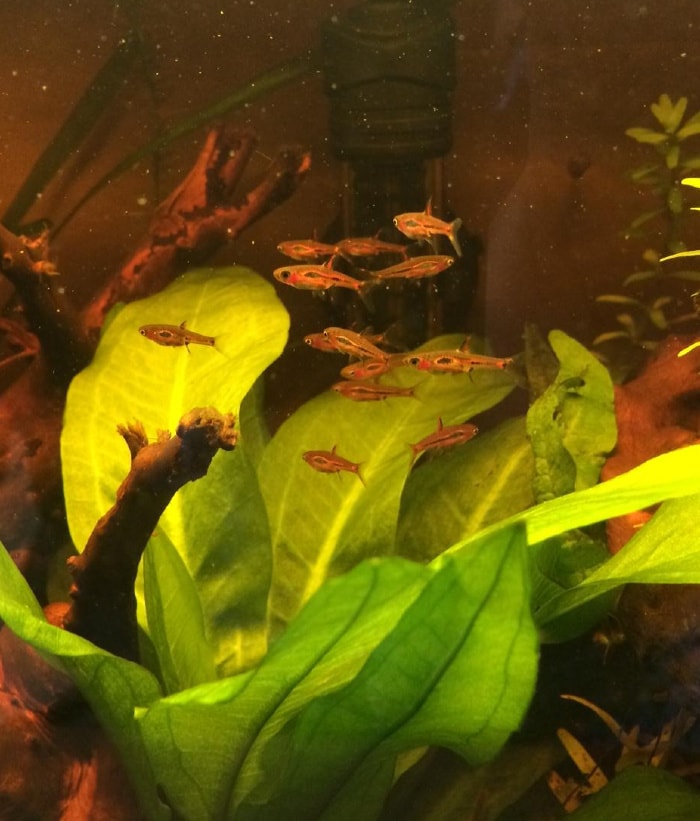
by King of Hyrule
As long as your aquarium mimics the natural environment of the Chili Rasbora you will eventually breed this fish.
Here are the tank requirements for breeding Chili Rasbora fish:
- Feed exclusively live or freeze-dried foods and avoid pellets or flakes.
- Keep the aquarium water at between 80 and 82ºF (26.6 to 28ºC)
- Maintain acidic water with a pH of below 6.5 and, ideally, around 5.0
- General hardness of the water should be between 1 and 5 dGH
Dim lighting and live plants such as Java Moss could aid the breeding process but are not necessary for success.
Having some leaves or bogwood that leach tannins in the tank also makes your Chili Rasbora fish feel more at home.
Offering live foods twice a day will also encourage spawning.
Anyway, here’s how to take care of Chili Rasbora fry:
When spawning, a female Chili Rasbora will scatter her eggs around the tank. She will deliver one to two eggs daily, totaling up to 12 in a week.
The adults will not actively try to eat their eggs, but given the opportunity – they will.
Chili Rasboras have no parental instinct so they will not take care of their young.
The fry should be fed with micro foods such as Infusoria cultures for up to a week.
After that, the Chili Rasbora fry will be large enough to accept micro worms and baby Brine shrimp.
Don’t do water changes for the first 10 days of spawning in order to avoid shifting the chemical makeup of the water too abruptly.
Pro tip: To encourage higher survivability of the young, move two to three pairs of adult Chili Rasboras to a small, 2.5 to 4-gallon tank. Use marbles or Java moss on the bottom of the breeding tank to protect the eggs and fry from getting eaten. Remove the adult fish a week after the spawning has started.
Where to buy Chili Rasboras?
Though there’s a high demand for these nano fish, Chili Rasboras are not commonly found in your local fish store.
Do check each around your area, but it’s not guaranteed you’d find them for sale.
However, online aquarium stores dedicated to selling live fish usually offer the magnificent Chili Rasbora. Visit the link to see some of my recommendations on where to buy yours.
Mind that the fish will likely arrive with slight discoloration, but in a week or two they’ll show their beautiful red color.
Don’t forget to cycle your new fish tank before putting live fish in it.
Anyway, you now know enough to take proper care of the Chili Rasbora in your home aquarium.
Leave me a comment if you have any questions or just want to share your experience.



